Seoyoung Lee
FLARE: FP-Less PTQ and Low-ENOB ADC Based AMS-PiM for Error-Resilient, Fast, and Efficient Transformer Acceleration
Nov 22, 2024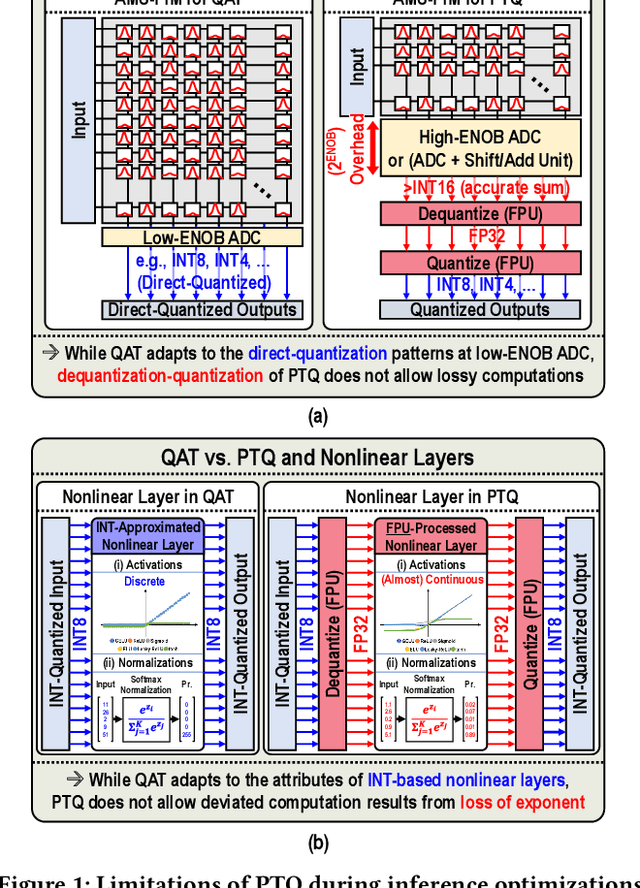
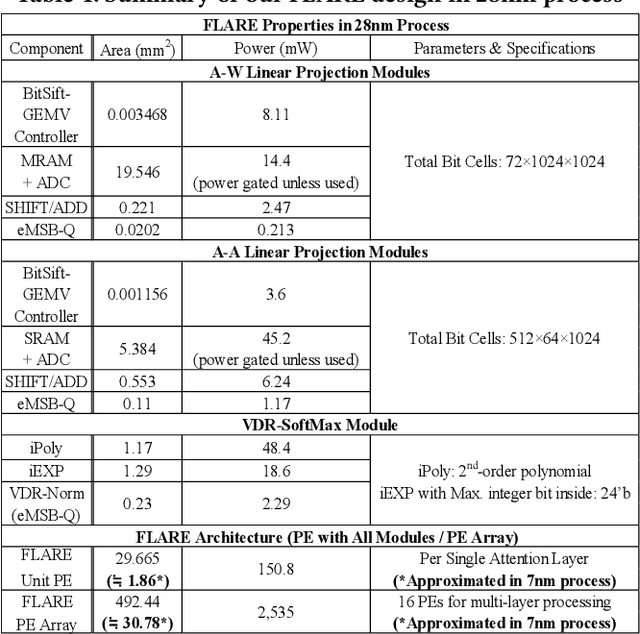
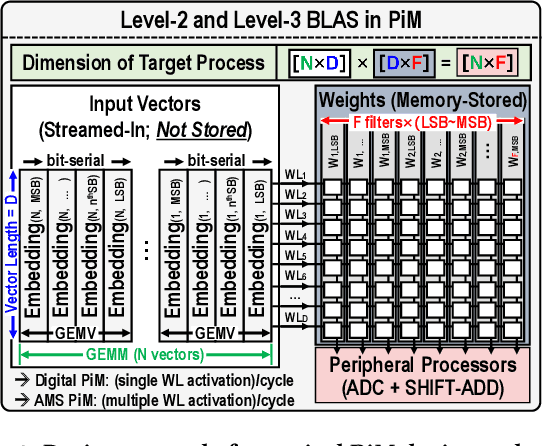
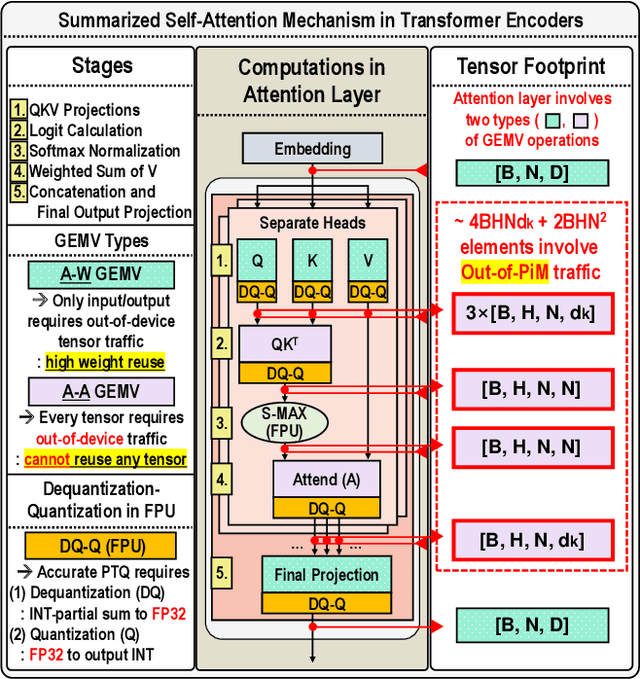
Abstract:Encoder-based transformers, powered by self-attention layers, have revolutionized machine learning with their context-aware representations. However, their quadratic growth in computational and memory demands presents significant bottlenecks. Analog-Mixed-Signal Process-in-Memory (AMS-PiM) architectures address these challenges by enabling efficient on-chip processing. Traditionally, AMS-PiM relies on Quantization-Aware Training (QAT), which is hardware-efficient but requires extensive retraining to adapt models to AMS-PiMs, making it increasingly impractical for transformer models. Post-Training Quantization (PTQ) mitigates this training overhead but introduces significant hardware inefficiencies. PTQ relies on dequantization-quantization (DQ-Q) processes, floating-point units (FPUs), and high-ENOB (Effective Number of Bits) analog-to-digital converters (ADCs). Particularly, High-ENOB ADCs scale exponentially in area and energy ($2^{ENOB}$), reduce sensing margins, and increase susceptibility to process, voltage, and temperature (PVT) variations, further compounding PTQ's challenges in AMS-PiM systems. To overcome these limitations, we propose RAP, an AMS-PiM architecture that eliminates DQ-Q processes, introduces FPU- and division-free nonlinear processing, and employs a low-ENOB-ADC-based sparse Matrix Vector multiplication technique. Using the proposed techniques, RAP improves error resiliency, area/energy efficiency, and computational speed while preserving numerical stability. Experimental results demonstrate that RAP outperforms state-of-the-art GPUs and conventional PiM architectures in energy efficiency, latency, and accuracy, making it a scalable solution for the efficient deployment of transformers.
Expressive Gaussian Human Avatars from Monocular RGB Video
Jul 03, 2024



Abstract:Nuanced expressiveness, particularly through fine-grained hand and facial expressions, is pivotal for enhancing the realism and vitality of digital human representations. In this work, we focus on investigating the expressiveness of human avatars when learned from monocular RGB video; a setting that introduces new challenges in capturing and animating fine-grained details. To this end, we introduce EVA, a drivable human model that meticulously sculpts fine details based on 3D Gaussians and SMPL-X, an expressive parametric human model. Focused on enhancing expressiveness, our work makes three key contributions. First, we highlight the critical importance of aligning the SMPL-X model with RGB frames for effective avatar learning. Recognizing the limitations of current SMPL-X prediction methods for in-the-wild videos, we introduce a plug-and-play module that significantly ameliorates misalignment issues. Second, we propose a context-aware adaptive density control strategy, which is adaptively adjusting the gradient thresholds to accommodate the varied granularity across body parts. Last but not least, we develop a feedback mechanism that predicts per-pixel confidence to better guide the learning of 3D Gaussians. Extensive experiments on two benchmarks demonstrate the superiority of our framework both quantitatively and qualitatively, especially on the fine-grained hand and facial details. See the project website at \url{https://evahuman.github.io}
Towards Efficient Neural Scene Graphs by Learning Consistency Fields
Oct 09, 2022
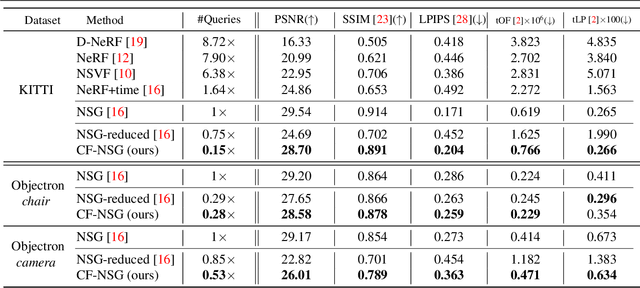
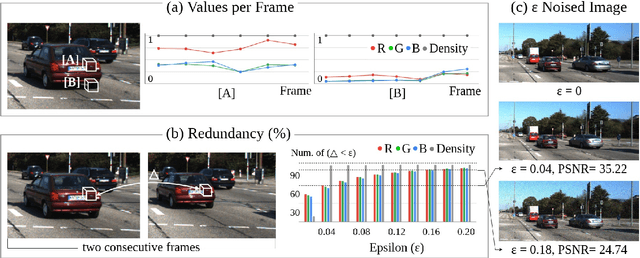

Abstract:Neural Radiance Fields (NeRF) achieves photo-realistic image rendering from novel views, and the Neural Scene Graphs (NSG) \cite{ost2021neural} extends it to dynamic scenes (video) with multiple objects. Nevertheless, computationally heavy ray marching for every image frame becomes a huge burden. In this paper, taking advantage of significant redundancy across adjacent frames in videos, we propose a feature-reusing framework. From the first try of naively reusing the NSG features, however, we learn that it is crucial to disentangle object-intrinsic properties consistent across frames from transient ones. Our proposed method, \textit{Consistency-Field-based NSG (CF-NSG)}, reformulates neural radiance fields to additionally consider \textit{consistency fields}. With disentangled representations, CF-NSG takes full advantage of the feature-reusing scheme and performs an extended degree of scene manipulation in a more controllable manner. We empirically verify that CF-NSG greatly improves the inference efficiency by using 85\% less queries than NSG without notable degradation in rendering quality. Code will be available at: https://github.com/ldynx/CF-NSG
 Add to Chrome
Add to Chrome Add to Firefox
Add to Firefox Add to Edge
Add to Edge